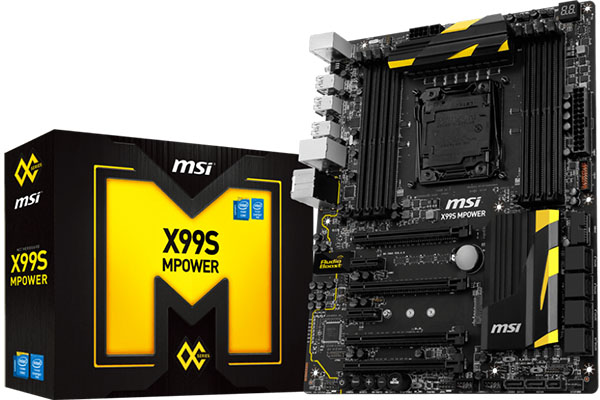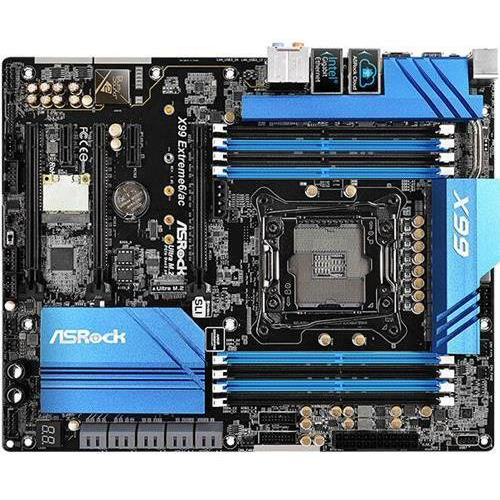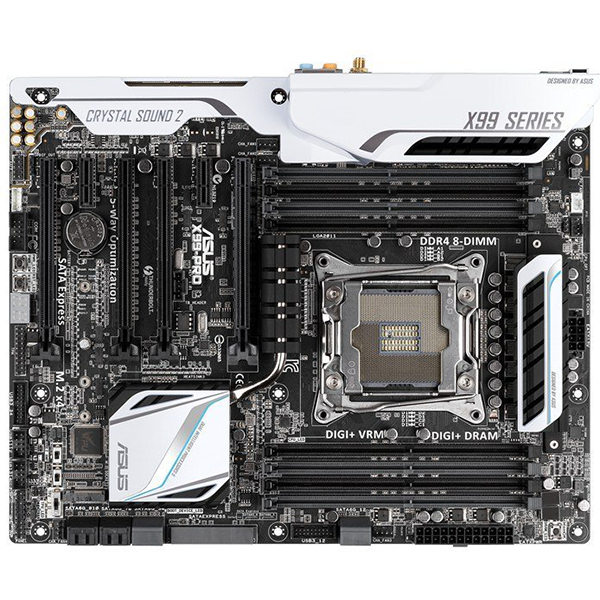Early Verdict
Priced and valued $35 higher than MSI’s award-winning X99S Gaming 7, the X99S MPower struggles to earn the firm a second award.
Pros
- +
The X99S MPower supports 3-way SLI and PCIe 3.0 M.2 simultaneously, on both 40-lane and 28-lane processors. Advanced overclocking features such as slow-mode for booting with LN2, an oversized voltage regulator, a row of barely-accessible voltage detection points, and a pair of BCLK adjustment buttons may entice overclocking exhibitionists.
Cons
- -
Few of the X99S MPower’s upgrades are likely to attract ordinary Air & Water overclocking enthusiasts.
Why you can trust Tom's Hardware
Love, Lust And That Other Thing
What does it take to make a $300 motherboard? Combining Intel’s premium on the X99 chipset with the added motherboard layers needed to support its 2011-pin CPU interface, we can understand why entry-level motherboards come at a decidedly non-mainstream price. But if $250 can buy us a great board, and if most of the features needed to make those platforms “high-end” are already built into the chipset, what feature is so important that enthusiasts should pay an extra $50 to get it?
Asus answered that with 802.11ac Wi-Fi. ASRock decided that wasn’t enough and added dual GbE plus the 802.11ac controller. Yet, I slammed both of those boards for dropping the third PCIe 3.0 graphics slot whenever a PCIe-based M.2 drive was installed. It’s not that PCIe M.2 and three-way SLI are super popular, but rather that both vendors went cheap on PCIe 3.0 lane switches and caused the conundrum. If you’re going to charge someone $300 for a motherboard, don't leave out a few minor components.
You could say that we love the X99’s integrated features. Or you could say that we have an issue with products that don’t implement them properly. Either way, MSI’s X99S MPower includes the low-cost components needed to overcome its competitors' biggest headaches. But what of lust? Didn’t we see a similar slot configuration on the company’s own X99S Gaming 7? Which X99S MPower features will entice us to pay a $35-higher price?
| X99 High-End Motherboard Features | |||
|---|---|---|---|
| Row 0 - Cell 0 | MSI X99S MPower | ASRock X99 Extreme6/ac | Asus X99 Pro |
| PCB Revision | 4.0 | 1.07 | 1.01 |
| Chipset | Intel X99 | Intel X99 | Intel X99 |
| Voltage Regulator | 12 Phases | 12 Phases | Eight Phases |
| 100.0 MHz BCLK | 99.98 (-0.02%) | 99.94 (-0.06%) | 99.94 (-0.06%) |
| I/O Panel Connectors | |||
| P/S 2 | 1 | 1 | 1 |
| USB 3.0 | 8 | 6 | 6 |
| USB 2.0 | 2 | 2 | 4 |
| Network | 1 | 2 | 1 |
| eSATA | None | 1 | None |
| CLR_CMOS Button | 1 | 1 | 1 |
| Digital Audio Out | Optical | Optical | Optical |
| Digital Audio In | None | None | None |
| Analog Audio | 5 | 5 | 5 |
| Other Devices | None | 2x Wi-Fi Antenna | 2x Wi-Fi Antenna |
| Internal Interfaces | |||
| PCIe 3.0 x16 (Core i7-5960X, -5930K) | 4 (x16/x16/x0/x8*, x8/x16/x8/x8*) SLI x4, CrossFire x4, *=Forces M.2 to PCIe 2.0 x2 | 3 (x16/x16/x8) SLI x3, CrossFire x3, M.2 disables x8 slot | 3 (x16/x16/x8) SLI x3, CrossFire x3, M.2 disables x8 slot |
| PCIe 3.0 x16 (Core i7-5820K) | 4 (x16/x8/x0/x4*, x8/x8/x8/x4*), SLI x3, CrossFireX x4, *=Forces M.2 to PCIe 2.0 x2 | 3 (x16/x8/x4), SLI x2, CrossFireX x3, M.2 disables x4 slot | 3 (x16/x8/x4), SLI x2, CrossFireX x3, M.2 disables x4 slot |
| PCIe 2.0 x16 | None | None | 1 (x4, shares 1x PCIe x1, 1x USB 3.0 controller [2-ports]) |
| PCIe 2.0 x1 | 2 (open-ended) | 2 (+1x Mini-PCIe, Filled) | 2 (1x w/x16, 1x w/Wi-Fi) |
| USB 3.0 | 2 (4-ports) | 2 (4-ports) | 2 (4-ports) |
| USB 2.0 | 2 (4-ports) | 2 (4-ports) | 2 (4-ports) |
| SATA 6.0 Gb/s | 10 (Shares M.2/SATA-E) | 10 (Shares M.2/SATA-E) | 10 (2x Shared w/SATA-E) |
| SATA Express | 1 (Uses 2x SATA) | None | 1 (Uses 2x SATA) |
| M.2 Interfaces (Transfer Modes) | 1 (PCIe 3.0 x4, PCIe 2.0 x2, SATA 6Gb/s x2) | 1 (PCIe 3.0 x4, SATA 6Gb/s x1) | 1 (PCIe 3.0 x4-only) |
| 4-Pin Fan | 5 | 2 | 6 (5x PWM/DC dual-mode) |
| 3-Pin Fan | None | 4 | None |
| FP-Audio | 1 | 1 | 1 |
| S/PDIF I/O | None | None | Output Only |
| Internal Buttons | Power, Reset, OC-Genie, Clock +/- | Power, Reset | Power, Reset, Mem_OK |
| Internal Switch | Slow Mode, BIOS Selector | Dual BIOS Selector | XMP, EPU (low-energy), TPU (auto-overclocking) |
| Diagnostics Panel | Numeric | Numeric | Numeric |
| Other Devices | None | Serial COM, TB_Header, HDD-Saver, USB Type-A | Serial COM, TB_Header, EXT_FAN |
| Mass Storage Controllers | |||
| Chipset SATA | 10x SATA 6Gb/s (Includes M.2, SATA-E) | 10x SATA 6Gb/s (Includes M.2, eSATA) | 10x SATA 6Gb/s (Includes M.2, SATA-E) |
| Chipset RAID Modes | 0, 1, 5, 10 (Ports 1-6) | 0, 1, 5, 10 (Ports 1-6) | 0, 1, 5, 10 (Ports 1-6) |
| Add-In SATA | None | None | None |
| USB 3.0 | VL805 PCIe ASM1042 PCIe | ASM1042e PCIe ASM1072 Hub | ASM1042e PCIe ASM1072 Hub |
| Networking | |||
| Primary LAN | Intel i210 PCIe | WGI218V PHY | WGI218V PHY |
| Secondary LAN | None | AR8171 PCIe | None |
| WiFi | None | BCM4352 PCIe 802.11ac dual-band / BT 4.0 | BCM4352 PCIe 802.11ac dual-band / BT 4.0 |
| Bluetooth | None | BT 4.0 / Wi-Fi Combo | BT 4.0 / Wi-Fi Combo |
| Audio | |||
| HD Audio Codec | ALC1150 | ALC1150 | ALC1150 |
| DDL/DTS Connect | None | DTS Connect | DTS Connect |
| Warranty | Three Years | Three Years | Three Years |
Today we’re comparing MSI’s X99S MPower to its closest rivals. But a look back at the X99S Gaming 7 review reveals that the MPower gains only a slightly larger voltage regulator, a slow-mode switch to assist extreme overclockers at boot, dual BIOS and a couple of buttons for firmware-level overclocking. None of these are particularly lust-worthy, though the aforementioned extreme overclockers might find value in the small upgrades.
Get Tom's Hardware's best news and in-depth reviews, straight to your inbox.
-
dovah-chan Have you guys gotten a sample of the X99S SLI Plus? I'm pretty interested in it because of its matte black scheme. Also it's a nicely priced board (for 2011-3 standards) that has guaranteed support for Xeons and ECC RAM.Reply
Maybe a throw down between it and Asus's X99-E WS for what board takes the workstation crown? -
Crashman Yes, the SLI Plus arrived late for the roundup that included the Gaming 7. Since the Gaming 7 had arrived on time, the substitute model is still sitting in the intake bin :)Reply -
ElHarry PCIe 3.0 switches are not really minor components. They may not be very exciting, but they are a pain in the as to work with.Reply -
Wizard5678 I like these motherboards and I have enjoyed your site content. Where else can someone source these items?Reply -
Crashman Reply
They're inexpensive (the ones that don't have logic) and available on cheap Z97 motherboards, so one would think that implementing them on an X99 board (rather than shutting things off) would be a priority.15211412 said:PCIe 3.0 switches are not really minor components. They may not be very exciting, but they are a pain in the as to work with.
-
RedJaron Reply
Why do you say that?15237958 said:mobo reviews are so useless..like ones for ram modules..




